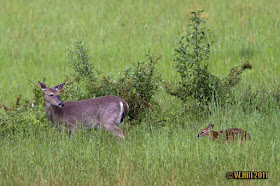 |
| First Fawn of 2011-May 18th Canon 7D-500mm |
In a few minutes a young doe approached and circled around looking at the edge of the woods with interest. When she moved on, I cautiously approached with the T3i and video tripod. There was the fawn--hidden in the weeds and grass at the edge of the woods. After filming it, I took several still photos with that camera and the 100-400mm lens, before going back to my stand and getting the 7D and 500mm lens.
 |
| First Fawn 2012: May 28th: Canon 7D 500mm |
This morning found me at the meadow again at dawn, I soon saw a fawn nursing from a doe at the edge of the woods, but the grass was tall and I didn't get any photographs. In about an hour I saw a fawn crossing the food plot, but it was too far for good photographs.
At 8:00 I saw a fawn emerge from the tall grass in another sector of the meadow. This was close enough for good video and I filmed it for awhile and then began to work a bit closer with the 500mm and the 7D. Just as I got to an acceptable range, the fawn dropped down at the border between a strip of grass and a food plot of oats, Essex dwarf rape, and clover. It was now to close for the 500mm so I carefully worked into position with the T3i and 100-400mm lens and filmed it from several angles, before getting into a head on position. After I had enough footage, I switched to shooting stills and alternated between the 7D and T3i bodies.
 |
| Young Fawn: Canon T3i 100-400mm at 135mm ISO 160 |
What is "Magic Lantern", many will ask. That is definitely a subject for another time, but suffice it to say it is not for the casual user nor the faint of heart.
Originally posted at Pennsylvania Wildlife Photographer by Willard Hill
